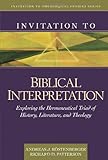Invitation to biblical interpretation : exploring the hermeneutical triad of history, literature, and theology / Andreas J. Kostenberger, Richard D. Patterson. [print]
Material type: TextSeries: Invitation to theological studies seriesPublication details: Grand Rapids, Michigan : Kregel Publications, (c)2011.Description: 891 pages : illustrations ; 24 cmContent type:
TextSeries: Invitation to theological studies seriesPublication details: Grand Rapids, Michigan : Kregel Publications, (c)2011.Description: 891 pages : illustrations ; 24 cmContent type: - text
- unmediated
- volume
- 9780825430473
- BS476.P318.I585 2011
- BS476
- COPYRIGHT NOT covered - Click this link to request copyright permission:
| Item type | Current library | Collection | Call number | Status | Date due | Barcode | |
|---|---|---|---|---|---|---|---|
 Circulating Book (checkout times vary with patron status)
Circulating Book (checkout times vary with patron status)
|
G. Allen Fleece Library CIRCULATING COLLECTION | Non-fiction | BS476.K67 2011 (Browse shelf(Opens below)) | Available | 31923001841382 |
Browsing G. Allen Fleece Library shelves, Shelving location: CIRCULATING COLLECTION, Collection: Non-fiction Close shelf browser (Hides shelf browser)

|

|

|

|

|

|

|
||
| BS476.K545 2004 Introduction to biblical interpretation / | BS476.K545 2017 Introduction to biblical interpretation / | BS476.K665 2014 Reading the way to heaven : a Wesleyan theological hermeneutic of scripture / | BS476.K67 2011 Invitation to biblical interpretation : exploring the hermeneutical triad of history, literature, and theology / | BS476.K73 2002 The historical-critical method / | BS476.K764.M676 2022 Mormon hermeneutics : five approaches to the Bible by the LDS church / | BS476.L35 1985 Text and reality : aspects of reference in Biblical texts / |
The who, why, and how of interpretation. Welcome to the hermeneutical triad: history, literature, and theology -- Interpretation: the hermeneutical triad. The context of scripture: history. Setting the stage: historical-cultural background -- The focus of scripture: literature. The Old Testament canon: the law, the prophets, and the writings -- The New Testament canon: the gospels, Acts, epistles, and apocalypse -- Enjoying a good story: Old Testament historical narrative -- A word from the wise: poetry and wisdom -- Back to the future: prophecy -- Hearing the good news: New Testament historical narrative (gospels and Acts) -- Calling for discernment: parables -- Going by the letter: epistles -- Visions of the end: apocalyptic literature (Revelation) -- The importance of context: grammar, syntax, and discourse -- The meaning of words: linguistics, semantics, and exegetical fallacies -- A way of speaking: interpreting figurative language -- The goal: theology. Making the connection: getting our theology from the Bible -- Application and proclamation: God's word coming to life. Getting down to earth: using the tools, preaching and applying the word.
"Bible scholars Andreas Kstenberger (NT) and Richard Patterson (OT) provide seminarians and upper-level collegians a textbook utilizing the 'hermeneutical triad' method. This approach to interpretation is based on giving due consideration to both the historical setting and the literary context, as well the theological message. Working through the major genres of Scripture and showing how their method applies to each one, they provide interpretive examples to guide the student in proper exegesis. In addition to the examples, each chapter concludes with exercises and assignments. Also included is a helpful 'Building a Biblical Studies Library' appendix" --
COPYRIGHT NOT covered - Click this link to request copyright permission:
There are no comments on this title.
